The cost of lameness in Irish dairy herds
Muireann Conneely MVB PhD, research officer (dairy cow and calf welfare), Teagasc, and Eoin Ryan, MVB MVM DipECBHM PCertBI PCertEE, European Specialist in Bovine Health Management, Assistant Professor in Farm Animal Clinical Studies, School of Veterinary Medicine, Veterinary Sciences Centre, University College Dublin discuss the effects that lameness has on the key drivers of farm profitability
Lameness is a painful condition which severely compromises cow welfare (Shearer et al, 2013), reduces longevity (Booth et al, 2004), fertility (Gabarino et al, 2004), and milk production (Bicalho et al, 2008), impacts environmental sustainability (Mostert et al, 2018) and, as such, is one of the most significant health and welfare issues facing the dairy sector worldwide.
Lameness describes any deviation from the normal walking gait of an animal, and is a clinical sign of a number of different conditions, rather than a disease in itself. The vast majority of lameness in dairy cows is due to lameness involving the foot, with the lateral claw of the hind leg and the medial claw of the foreleg most commonly affected due to the importance of these as the primary weight-bearing claws.
Foot disorders can be divided into two main categories: non-infectious (including white line disease, solar haemorrhages and sole ulcers) and infectious diseases (including digital dermatitis, foul in the foot and interdigital dermatitis). The most common lesions causing lameness on Irish dairy farms are non-infectious (Browne et al, 2022; Logan et al, 2023).
Estimated prevalences of lameness vary widely, but in general are lower for pasture-based systems and higher for indoor systems. Estimates range from as low as 3.8 per cent in year-round, pasture-based systems (Beggs et al, 2019) to 63 per cent in fully-housed systems (von Keyserlingk et al, 2012). Recent Irish research showed that the average prevalence of lameness on Irish dairy farms was nine per cent (Browne et al, 2022). However, all Irish studies have shown considerable inter-herd variation (Logan et al. 2023; Browne et al, 2022). In a study by Somers et al (2015), the average prevalence of lameness based on locomotion scoring in 10 Irish dairy herds varied from 11.6 per cent prior to breeding, to 14.6 per cent during the breeding period, to 11.6 per cent during the post-breeding period. However, 22.9 per cent of cows were identified as lame at least once during the course of the study.
This reinforces the importance of ongoing monitoring of lameness on farms and the lack of sensitivity of individual once-off prevalence estimates. Although the average lameness prevalence figure of nine per cent, found by Browne et al (2022), compares favourably to other countries, this nonetheless represents a significant source of economic loss as well as a welfare challenge in the herd. A lameness prevalence above 10 per cent is considered the threshold above which intervention is needed (EFSA, 2009), but even in herds with a lameness prevalence close to this threshold, up to 25 per cent of cows will have one lameness event per year. A recent study investigating welfare in Irish herds (Crossley et al, 2021) showed that the best performing farms had fewer than five per cent lame cows in their herds, indicating that a low level of lameness is achievable within a pasture-based system.
The economic costs of lameness are significant; lameness is estimated to be the third most costly health issue of dairy cows after mastitis and fertility (Bruijnis et al, 2010). The costs arise both directly and indirectly; direct costs include additional expenditure that is directly linked to the case of lameness (such as additional farm labour, cost of hoof trimming and veterinary treatment, decreased milk production, and the cost of milk withdrawal if milk has to be discarded owing to drug treatments), while indirect costs arise due to the side effects of lameness. These include reduced reproductive performance and early culling. The greatest costs related to the disease are generally losses in production, such as reproductive performance and milk yield (Willshire and Bell, 2009), but these costs may the ones of which farmers are the least aware, as they do not have to pay directly for them at the time.
In addition to the economic cost, lameness presents a huge welfare cost to cows themselves, as it causes discomfort and pain, and negatively affects the cows’ normal feeding, lying and other behaviours (Whay et al, 2005). Lameness also has environmental costs because lame animals are less productive, therefore emissions per kg of milk are increased (Mostert et al, 2018; Chen et al, 2016). However, this article will focus on the economic cost alone; below, we discuss the effects that lameness has on the key drivers of farm
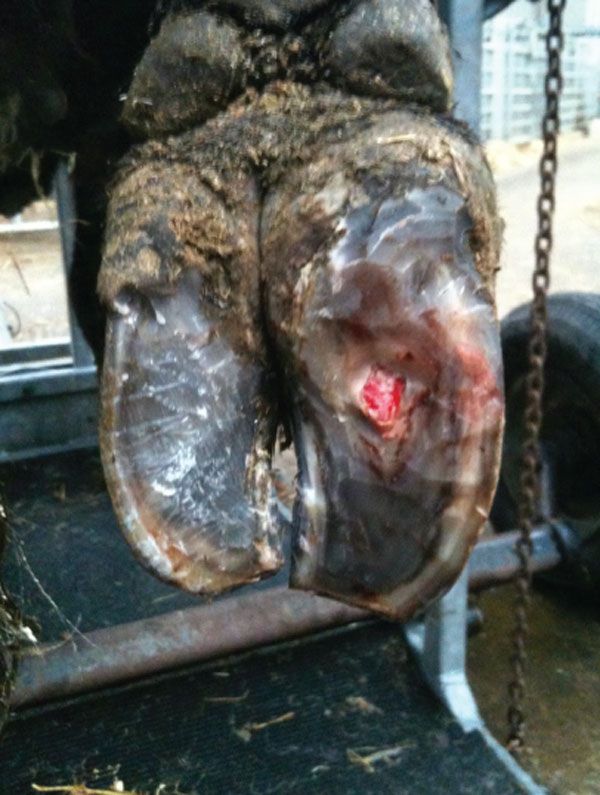
Figure 1: Sole ulcer.
Lameness and milk yield
Numerous studies have shown that lameness lowers the milk yield of dairy cows. This happens for a number of reasons: 1) lame cows are in pain, and as a result prefer to spend more time lying down to take weight off the painful limb, at the expense of eating (Sogstad et al, 2007; Miguel-Pacheco et al, 2014), and 2) an increased level of cortisol (released as a stress response to pain) can negatively affect rumen function.
The reduction in milk production caused by lameness varies depending on a number of factors. The point in the lactation at which it occurs is critical; if the lameness occurs once peak lactation has passed, the effects on total milk production over the course of the lactation will be less than if the lameness episode occurs before peak production. Parity also has an impact; higher parity cows have a greater milk yield and greater reduction in yield as a result. The production potential of the cow is also important; recent research has clearly demonstrated that it is the higher-yielding cows that are at greatest risk of becoming lame (Amory et al, 2008; Bicahlo et al, 2008; Green et al, 2002).
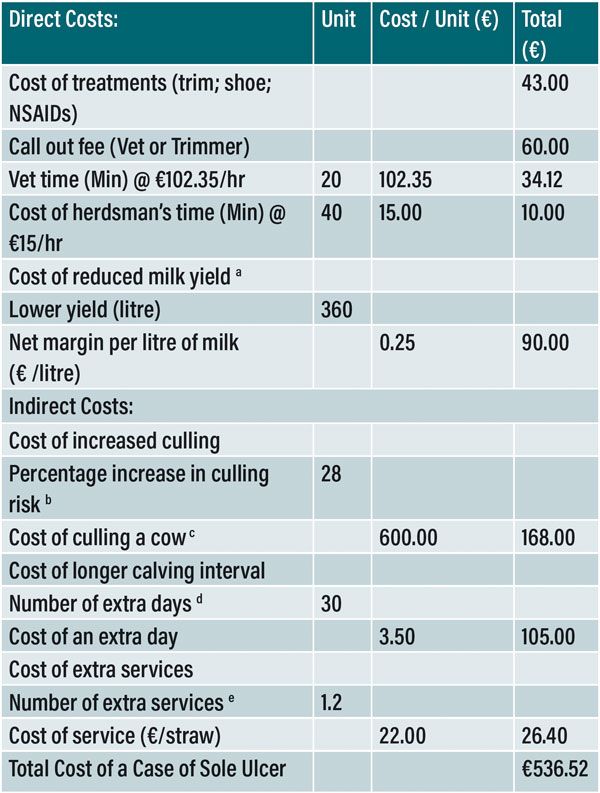
Milk yield loss with sole ulcer = 6 per cent reduction in annual milk yield for a MS 3 cow (O’Connor et al, 2023) from a herd with an average herd 305 day yield of 6000L (average annual milk yield of dairy cow in Ireland).
Culling risk of 28 per cent taken from O’Connor et al. (2023) for MS 3.
Calculated as: Return from cull sale – (cost of replacement heifer + lower margin from heifer + lower value of smaller calf from heifer), based on current market figures as of February 2024.
Taken from: Esslemont, R. J., Kossaibati, M. (2002). “The cost of poor fertility and disease in UK dairy herds.” Daisy research report No.5.
Taken from: Huxley J 2013. Impact of lameness and claw lesions in cows on health and production. Livestock Science 156, 64–70.
Table 1: Cost of sole ulcer.
Therefore, there is a tendency for the milk production of high-yielding cows in the herd to return to average, rather than average-yielding cows to become low-yielding. Other important factors include the severity of the lesion (lesions of greater severity will produce a greater reduction in yield), and how early the lameness is identified and treated. Many studies report milk losses occurring up to five months after the diagnosis of lameness (Green et al, 2002), while more recent research has shown that yields can drop as much as three months prior to diagnosis (Amory et al, 2008; Green et al, 2010). Identifying lameness earlier means the lesion will be at a less severe stage when treatment is instigated; cows will recover from lameness more quickly (Leach et al, 2012), and milk production losses can be minimised.
The reduction in milk production caused by lameness reported by various studies is difficult to compare for a number of reasons, including: varying definitions of lameness, different methodologies used for the analysis, and different methods of presenting data (some studies report lost production per day, while others report total losses over the entire lactation). Furthermore, studies have been conducted in many different types of cows with varying levels of baseline yields. Some studies have quantified the effect of lameness in general (not related to a specific condition), some have examined the effects relating to specific foot disorders, while others have examined the effect of different severities of lameness on milk yield. Considering studies that have reported milk losses over an entire lactation, losses range from 270kg and 574kg (Huxley, 2013). In an Irish study by O’Connor et al (2023), significant milk yield losses of up to 1.6 per cent of the average yield were associated with mobility score (MS)2 (on a 0-3 scale, with 0 representing normal mobility and 3 representing severely impaired mobility; AHDB 2013), and yield losses of up to six per cent were associated with MS3.
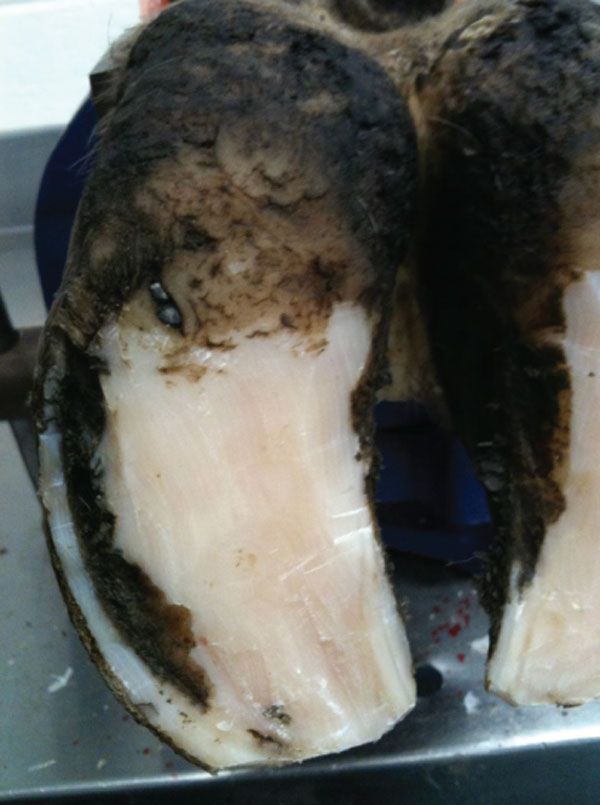
Figure 2: White line disease (WLD).
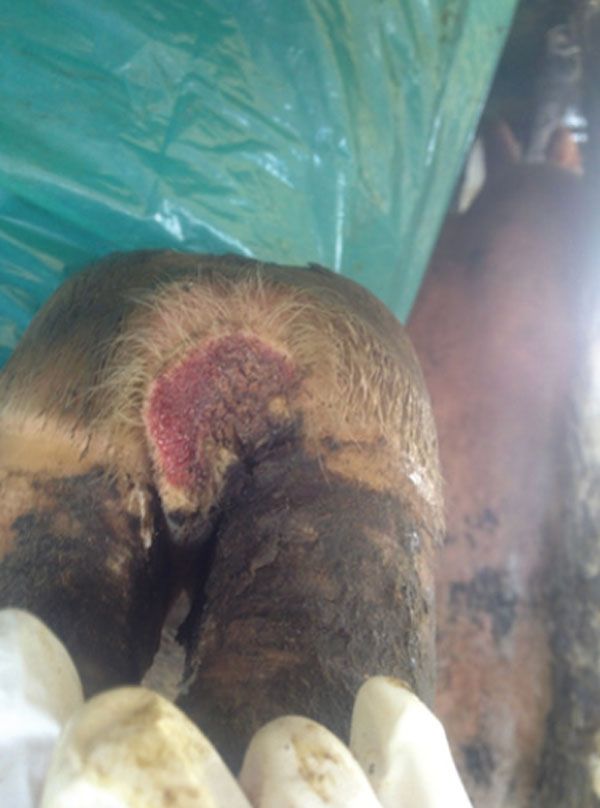
Figure 3: Mortellaro’s Digital Dermatitis.
Lameness and reproductive performance
It is also well-established that lameness negatively affects reproductive performance. Lame cows have reduced fertility for a number of reasons. The pain associated with lameness significantly alters their behaviour and they show less signs of oestrus, making it more difficult for the farmer to detect them in heat. Lame cows have increased inflammatory and stress indicators, which alters the functioning of the hypothalamus–pituitary–ovarian axis. They also eat less (González et al, 2008), and have longer and deeper periods of negative energy balance; which in turn leads to suppressed reproductive performance.
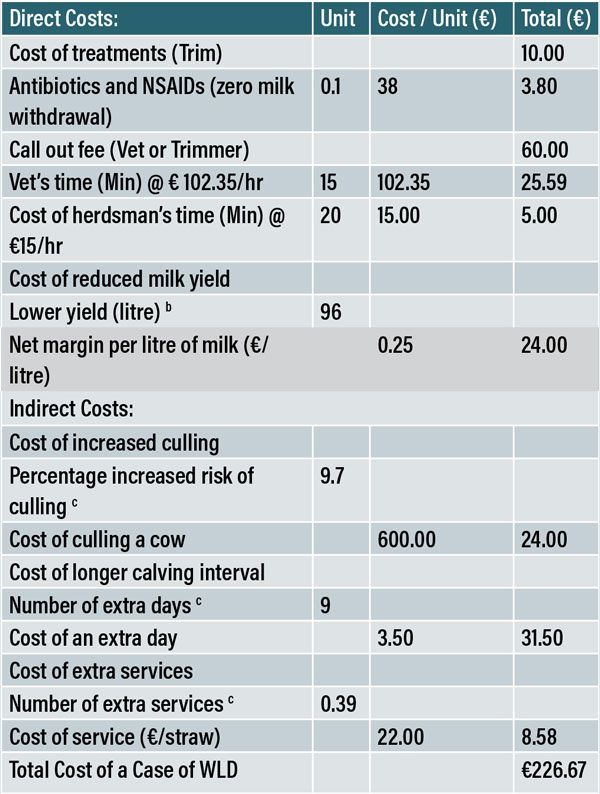
WLD in this calculation includes a 10 per cent incidence of severe cases of foot abscess or toe necrosis
Milk yield loss with WLD = 1.6 per cent reduction in annual milk yield for a MS 2 cow (O’Connor et al, 2023) from a herd with an average herd 305 day yield of 6000L
Taken from: Esslemont, R. J., Kossaibati, M. (2002). “The cost of poor fertility and disease in UK dairy herds.” Daisy research report No.5.
Table 2: Cost of White Line Disease (WLD) a.
This is seen as lower submission rate to first service (Somers et al, 2015), delayed ovarian cyclicity (Garbarino et al, 2004), reduced conception rate (Bicalho et al, 2007; Alawneh et al, 2010; Mellado et al, 2018), increased interval between calving and conception (Alawneh et al, 2010), and increased incidence of ovarian cysts (Melendez et al, 2003). Lame cows also seem to be more prone to uterine infections post-partum and have higher pregnancy losses (Tsousis, 2022)
As with milk yield, the timing of the lameness event is critical in determining the extent of reduced reproductive performance (Lucey et al, 1986); if it occurs later in lactation after the establishment of pregnancy, the effect will be less than if it occurs before first breeding. However, the effect of late lactation lameness on reproductive performance in the subsequent lactation has yet to be investigated. Also influencing the effect on reproductive performance are the type and severity of lameness (DoleCheck and Bewley, 2018).
Huxley (2013) summarised a number of studies that examined the effects of lameness on reproductive performance. Key effects noted include: a mean of seven days longer time to first service, 30 days increase in days open, 20 per cent lesser conception rate, and 1.2 more services per conception. Recent Irish research demonstrated that MS2 could increase the calving interval length by 3.5 days, whereas MS3 could increase it by six days (O’Connor et al, 2020).
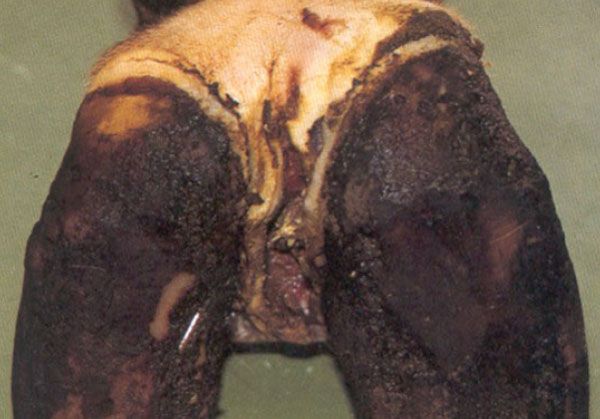
Figure 4: Interdigital Necrobacillosis/foul in the foot/footrot.
Lameness and culling
Most research shows that lame cows are more likely to be culled (Booth et al, 2004; Machado et al, 2010). A recent study in Spain reported that if a heifer had a case of solar ulcer or white line disease in her first lactation, this reduced her productive life by 71 days (Charfeddine, N. and Perez-Cabal, M.A., 2017). Irish research has found that as mobility score increased, so too did the risk of a cow being culled.
A cow with MS1 was 16 per cent more likely to be culled than a cow with perfect mobility, a cow with MS2 was almost 50 per cent more likely to be culled, and a cow with MS3 was nearly four times as likely to be culled (O’ Connor et al, 2020). It is challenging to obtain a true figure for the number of cows being culled due to lameness, because in many cases the recorded reason may be infertility, when in fact the cause of the reduced fertility may be lameness. This is an area that warrants further research.
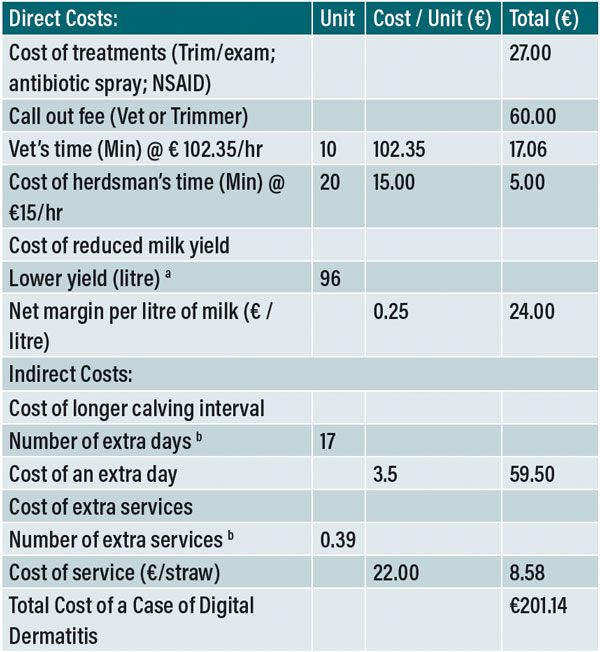
Milk yield loss with WLD = 1.6 per cent reduction in annual milk yield for a MS 2 cow (O’Connor et al, 2023) from a herd with an average herd 305 day yield of 6000L
Taken from: Esslemont, R. J., Kossaibati, M. (2002). “The cost of poor fertility and disease in UK dairy herds.” Daisy research report No.5.
Table 3: Cost of digital dermatitis.
Estimating cost of lameness
Many studies have used different methods to estimate the costs of lameness, both in terms of the costs of lameness in general (partial budget, Guard, 2008; simulation model, Liang et al, 2017) and also the costs relating to individual specific claw disorders (partial budgeting, Willshire and Bell, 2009; dynamic optimisation programming, Cha et al, 2010; deterministic model, Charfeddine and Perez-Cabal, 2017). Estimating the precise cost of lameness is problematic for a number of reasons. Few studies to date have included costs associated with lameness control or prevention, interactions with other diseases, interaction of different lesion types with each other, recurrence of lameness, and losses associated with animal welfare (including the effect on consumer perception, which may affect market demand for dairy products; Dolecheck and Bewley 2018).
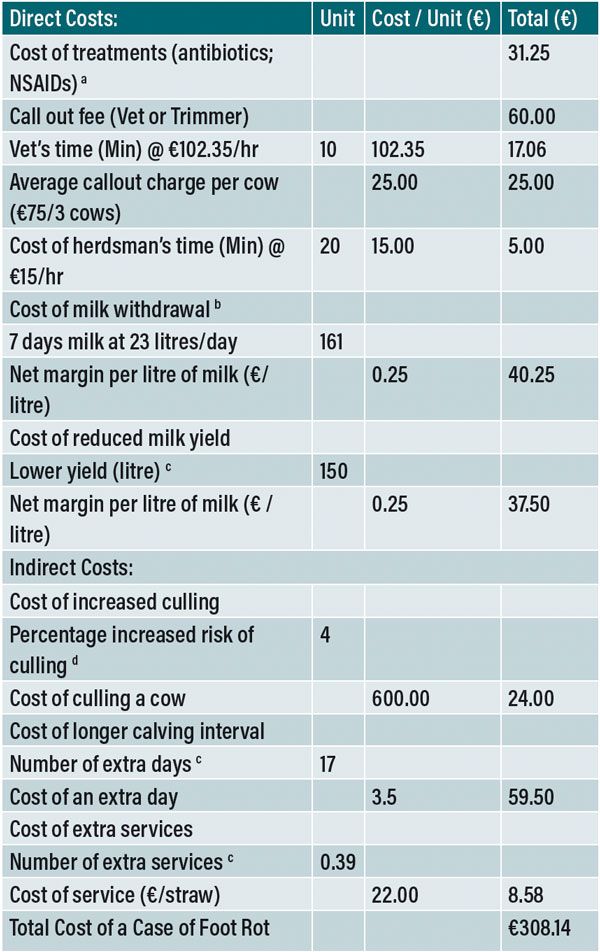
The cost of treatment of footrot was based on the average cost of 5 days of oxytetracycline/penicillin and one treatment with meloxicam
Milk withdrawals would not be present if a 2nd generation cephalosporin and zero milk withdrawal NSAID was used
Taken from: Esslemont, R. J., Kossaibati, M. (2002). “The cost of poor fertility and disease in UK dairy herds.” Daisy research report No.5.
Culling risk associated with severe cases involving ascending cellulitis
Table 4: Cost of foot rot.
Estimate of costs for individual hoof conditions
In Tables 1 to 5, we used a simple calculation to estimate the cost of a number of the most important conditions for an individual cow in Ireland. The tables show the costs of lameness calculated for a 100-cow herd, in three different lameness prevalence scenarios. The calculation can be tailored to each individual herd based on the prevalence of lameness and lesion types identified.
Take home message
Lameness is a costly condition and can be a significant source of lost profit for farmers. The other great cost is to the welfare of the cow herself. Taking steps to reduce lameness prevalence within the herd will improve cow welfare and increase farm profitability.
For further information on lameness prevention and management, see https://animalhealthireland.ie/bulletin-cat/hoof-healthcheck-bulletin/ and https://www.teagasc.ie/publications/2022/reducing-lameness-in-irish-dairy-herds.php.

Table 5: Modelled herd cost of lameness cases for 100 cows/year.
AHDB 2013. AHDB dairy mobility score. https://ahdb.org.uk/knowledge-library/mobility-scoring-how-to-score-your-cows
Alawneh, J. I., R. A. Laven, and M. A. Stevenson. 2011. The effect of lameness on the fertility of dairy cattle in a seasonally breeding pasture-based system. Journal of Dairy Science 94(11):5487-5493.
Amory, J. R., Z. E. Barker, J. L. Wright, S. A. Mason, R. W. Blowey, and L. E. Green. 2008. Associations between sole ulcer, white line disease and digital dermatitis and the milk yield of 1824 dairy cows on 30 dairy cow farms in England and Wales from February 2003-November 2004. Preventive Veterinary Medicine 83(3-4):381-391.
Beggs, D., E. Jongman, P. Hemsworth, and A. Fisher. 2019. Lame cows on Australian dairy farms: A comparison of farmer-identified lameness and formal lameness scoring, and the position of lame cows within the milking order. Journal of dairy science 102(2):1522-1529.
Bicalho, R., F. Vokey, H. Erb, and C. Guard. 2007. Visual locomotion scoring in the first seventy days in milk: Impact on pregnancy and survival. Journal of dairy science 90(10):4586-4591.
Bicalho, R., L. Warnick, and C. Guard. 2008. Strategies to analyze milk losses caused by diseases with potential incidence throughout the lactation: A lameness example. Journal of dairy science 91(7):2653-2661.
Booth, C. J., L. D. Warnick, Y. T. Grohn, D. O. Maizon, C. L. Guard, and D. Janssen. 2004. Effect of lameness on culling in dairy cows. Journal of Dairy Science 87(12):4115-4122.
Browne, N., C. Hudson, R. Crossley, K. Sugrue, J. Huxley, and M. Conneely. 2022. Hoof lesions in partly housed pasture-based dairy cows. Journal of Dairy Science 105(11):9038-9053.
Bruijnis, M. R. N., H. Hogeveen, and E. N. Stassen. 2010. Assessing economic consequences of foot disorders in dairy cattle using a dynamic stochastic simulation model. Journal of Dairy Science 93(6):2419-2432.
Charfeddine, N. and M. A. Pérez-Cabal. 2017. Effect of claw disorders on milk production, fertility, and longevity, and their economic impact in Spanish Holstein cows. Journal of Dairy Science 100(1):653-665.
Chen, W., E. White, and N. M. Holden. 2016. The effect of lameness on the environmental performance of milk production by rotational grazing. J Environ Manage 172:143-150.
Crossley, R. E., E. A. M. Bokkers, N. Browne, K. Sugrue, E. Kennedy, I. J. M. de Boer, and M. Conneely. 2021. Assessing dairy cow welfare during the grazing and housing periods on spring-calving, pasture-based dairy farms. Journal of Animal Science 99(5).
Dolecheck, K. and J. Bewley. 2018. Animal board invited review: Dairy cow lameness expenditures, losses and total cost. animal 12(7):1462-1474.
EFSA. 2009. Scientific Opinion of the Panel on Animal Health and Welfare on a request from the Commission on the risk assessment of the impact of housing, nutrition and feeding, management and genetic selection on leg and locomotion problems in dairy cows. EFSA J. 1139:1-68.
Esslemont, R. J., Kossaibati, M. (2002). “The cost of poor fertility and disease in UK dairy herds.” Daisy research report No.5.
Garbarino, E. J., J. A. Hernandez, J. K. Shearer, C. A. Risco, and W. W. Thatcher. 2004. Effect of lameness on ovarian activity in postpartum Holstein cows. Journal of Dairy Science 87(12):4123-4131.
González, L., B. Tolkamp, M. Coffey, A. Ferret, and I. Kyriazakis. 2008. Changes in feeding behavior as possible indicators for the automatic monitoring of health disorders in dairy cows. Journal of dairy science 91(3):1017-1028.
Green, L., V. Hedges, Y. Schukken, R. Blowey, and A. Packington. 2002. The impact of clinical lameness on the milk yield of dairy cows. Journal of dairy science 85(9):2250-2256.
Green, L. E., J. Borkert, G. Monti, and N. Tadich. 2010. Associations between lesion-specific lameness and the milk yield of 1,635 dairy cows from seven herds in the Xth region of Chile and implications for management of lame dairy cows worldwide. Animal Welfare 19(4):419-427.
Guard C 2008. The costs of common diseases of dairy cattle. In Proceedings of the California Veterinary Conference, 1 October 2008, Lenexa, KS, USA, pp. 695–700.
Hernandez, J., J. K. Shearer, and D. W. Webb. 2002. Effect of lameness on milk yield in dairy cows. Journal of the American Veterinary Medical Association 220(5):640-644.
Huxley, J. N. 2013. Impact of lameness and claw lesions in cows on health and production. Livestock Science 156(1-3):64-70.
Leach, K. A., D. A. Tisdall, N. J. Bell, D. C. J. Main, and L. E. Green. 2012. The effects of early treatment for hindlimb lameness in dairy cows on four commercial UK farms. The Veterinary Journal 193(3):626-632.
Liang, D., L. Arnold, C. Stowe, R. Harmon, and J. Bewley. 2017. Estimating US dairy clinical disease costs with a stochastic simulation model. Journal of dairy science 100(2):1472-1486.
Logan, F., McAloon, C.G., Ryan, E.G., O’Grady, L., Duane, M., Deane, B., McAloon, C.I. Sensitivity and specificity of mobility scoring for the detection of foot lesions in pasture based Irish dairy cows. Journal of Dairy Science (2023); https://doi.org/10.3168/jds.2023-23928.
Lucey, S., G. Rowlands, and A. Russell. 1986. The association between lameness and fertility in dairy cows. The veterinary record 118(23):628-631.
Machado, V., L. Caixeta, J. McArt, and R. Bicalho. 2010. The effect of claw horn disruption lesions and body condition score at dry-off on survivability, reproductive performance, and milk production in the subsequent lactation. Journal of dairy science 93(9):4071-4078.
Melendez, P., J. Bartolome, L. Archbald, and A. Donovan. 2003. The association between lameness, ovarian cysts and fertility in lactating dairy cows. Theriogenology 59(3-4):927-937.
Mellado, M., E. Saavedra, L. Gaytán, F. Veliz, U. Macías-Cruz, L. Avendaño-Reyes, and E. García. 2018. The effect of lameness-causing lesions on milk yield and fertility of primiparous Holstein cows in a hot environment. Livestock Science 217:8-14.
Miguel-Pacheco, G. G., J. Kaler, J. Remnant, L. Cheyne, C. Abbott, A. P. French, T. P. Pridmore, and J. N. Huxley. 2014. Behavioural changes in dairy cows with lameness in an automatic milking system. Applied Animal Behaviour Science 150:1-8.
Mostert, P. F., C. E. van Middelaar, I. J. M. de Boer, and E. A. M. Bokkers. 2018. The impact of foot lesions in dairy cows on greenhouse gas emissions of milk production. Agricultural Systems 167:206-212.
O’Connor, A. H., E. A. M. Bokkers, I. J. M. de Boer, H. Hogeveen, R. Sayers, N. Byrne, E. Ruelle, and L. Shalloo. 2020. Associating mobility scores with production and reproductive performance in pasture-based dairy cows. Journal of Dairy Science 103(10):9238-9249.
O’Connor, A. H., L. Shalloo, E. A. M. Bokkers, I. J. M. de Boer, H. Hogeveen, R. Sayers, N. Byrne, and E. Ruelle. 2023. Modeling the economic impacts of mobility scores in dairy cows under Irish spring pasture-based management. Journal of Dairy Science 106(2):1218-1232.
Omontese, B. O., R. Bellet-Elias, A. Molinero, G. D. Catandi, R. Casagrande, Z. Rodriguez, R. S. Bisinotto, and G. Cramer. 2020. Association between hoof lesions and fertility in lactating Jersey cows. Journal of Dairy Science 103(4):3401-3413.
Pavlenko, A., C. Bergsten, I. Ekesbo, T. Kaart, A. Aland, and L. Lidfors. 2011. Influence of digital dermatitis and sole ulcer on dairy cow behaviour and milk production. Animal 5(8):1259-1269.
Shearer, J. K., M. L. Stock, S. R. Van Amstel, and J. F. Coetzee. 2013. Assessment and management of pain associated with lameness in cattle. Veterinary Clinics: Food Animal Practice 29(1):135-156.
Sogstad, Å., O. Østerås, T. Fjeldaas, and A. Refsdal. 2007. Bovine claw and limb disorders at claw trimming related to milk yield. Journal of dairy science 90(2):749-759.
Somers, J. R., J. Huxley, I. Lorenz, M. L. Doherty, and L. O’Grady. 2015. The effect of Lameness before and during the breeding season on fertility in 10 pasture-based Irish dairy herds. Irish Veterinary Journal 68.
Tsousis, G., C. Boscos, and A. Praxitelous. 2022. The negative impact of lameness on dairy cow reproduction. Reproduction in Domestic Animals 57(S4):33-39.
von Keyserlingk, M. A. G., A. Barrientos, K. Ito, E. Galo, and D. M. Weary. 2012. Benchmarking cow comfort on North American freestall dairies: Lameness, leg injuries, lying time, facility design, and management for high-producing Holstein dairy cows. Journal of Dairy Science 95(12):7399-7408.
Whay, H., A. Webster, and A. Waterman‐Pearson. 2005. Role of ketoprofen in the modulation of hyperalgesia associated with lameness in dairy cattle. Veterinary Record 157(23):729-733.
Willshire, J. and N. Bell. 2009. An economic review of cattle lameness. Cattle Practice 17(2):136-141.
1. What is the threshold of lameness prevalence above which intervention is needed?
A: Five per cent
B: 10 per cent
C: 15 per cent
D: 30 per cent
2 Which answer below is incorrect? Lameness causes economic loss through:
A: Reduced milk production
B: Reduced reproductive performance
C: Cost of hoof trimming and veterinary treatment
D: Delayed culling
3. Which of the below statements is correct:
A: Research suggests a case of solar ulcer or WLD in the first lactation can reduce the productive life of a heifer by 17 days
B: If a lameness event occurs before first breeding, the effect on reproductive performance will be less than if it occurs after the establishment of pregnancy
C: The total annual cost of lameness for a 100-cow herd with a 10 per cent prevalence of digital dermatitis, 10 per cent prevalence of WLD, and eight per cent prevalence of sole ulcer is estimated to be €8,750.26
D: Recent Irish research reported that MS2 could increase the calving interval length by two days
4. In a recent study, the milk yield losses ( percentage of average yield) associated with MS3 in Irish dairy cows was reported to be:
A: 1.6 per cent
B: 6 per cent
C: 20 per cent
D: 50 per cent
5. The total estimated cost of a case of white line disease in an Irish cow is estimated to be:
A: €227
B: €537
C: €201
D: €308
ANSWERS: 1B; 2D; 3C; 4B; 5A









